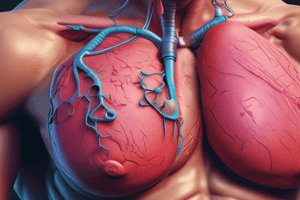Podcast
Questions and Answers
What term is used to describe a loose segment of the chest wall that impedes chest wall movement?
What term is used to describe a loose segment of the chest wall that impedes chest wall movement?
- Paradoxical respirations
- Mechanical ventilation
- Hemothorax
- Flail chest (correct)
Which assessment finding is characteristic of flail chest?
Which assessment finding is characteristic of flail chest?
- Decreased heart rate
- Severe abdominal pain
- Hyperresonance on percussion
- Diminished breath sounds (correct)
What intervention should nurses prepare for in a patient with flail chest?
What intervention should nurses prepare for in a patient with flail chest?
- Prepare for intubation and mechanical ventilation (correct)
- Encourage deep breathing exercises
- Prepare for cardiac catheterization
- Administer pain medication
Which term describes the inward movement of the free segment of thorax during inspiration, with outward movement during expiration?
Which term describes the inward movement of the free segment of thorax during inspiration, with outward movement during expiration?
What condition may result from flail chest?
What condition may result from flail chest?
Flashcards are hidden until you start studying
Study Notes
Flail Chest
- A type of blunt chest trauma associated with certain accidents, characterized by a loose segment of the chest wall that hinders expansion and contraction of the rest of the chest wall.
- Can result in hemothorax, a condition where blood accumulates in the space between the chest wall and lungs.
Assessment Findings
- Paradoxical respirations: inward movement of the free segment of thorax during inspiration, and outward movement during expiration.
- Severe chest pain.
- Diminished breath sounds.
Nursing Considerations
- Prepare for intubation and mechanical ventilation.
Studying That Suits You
Use AI to generate personalized quizzes and flashcards to suit your learning preferences.




